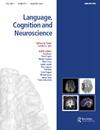Modulation of working memory capacity on predictive processing during language comprehension
IF 1.8
3区 医学
Q2 AUDIOLOGY & SPEECH-LANGUAGE PATHOLOGY
引用次数: 0
Abstract
ABSTRACT Ample evidence has shown facilitations of context-based prediction on language comprehension. However, the influential effect of working memory capacity on this predictive processing remains debated. To investigate this issue with the electroencephalograph technique, high and low working memory capacity participants read strong-, moderate- and weak-constraint sentences which resulted in high-, moderate- and low-predictability for the critical nouns. The strong-constraint (vs. weak-constraint) contexts preceding the nouns elicited a larger positive deflection, which was only observed for the high-span group. Along with the smaller N400s for strong- vs. weak-predictable nouns for both groups, the moderately predictable nouns elicited smaller N400 than the weakly predictable nouns for the high-span group. The ERP effects at both verbs and nouns correlated significantly with the noun’s predictability. These findings suggest that predictive processing involves at least partially an effortful-meaning-computation mechanism, and high working memory capacity facilitates the activation and integration of predicted information during language comprehension.语言理解中工作记忆容量对预测加工的调节
大量证据表明,基于语境的预测有助于语言理解。然而,工作记忆容量对这种预测加工的影响仍然存在争议。为了研究这一问题,使用脑电图技术,高、低工作记忆容量的参与者阅读强、中、弱约束句子,导致对关键名词的高、中、低可预测性。名词前的强约束语境(相对于弱约束语境)引起了更大的正向偏转,这只在高跨度组中观察到。除了两组中强可预测名词和弱可预测名词的N400值都较小外,中等可预测名词的N400值比高跨度组中弱可预测名词的N400值要小。动词和名词的ERP效应与名词的可预测性显著相关。这些发现表明,预测加工至少部分涉及一种努力-意义-计算机制,高工作记忆容量有助于语言理解过程中预测信息的激活和整合。
本文章由计算机程序翻译,如有差异,请以英文原文为准。
求助全文
约1分钟内获得全文
求助全文
来源期刊

Language Cognition and Neuroscience
AUDIOLOGY & SPEECH-LANGUAGE PATHOLOGY-BEHAVIORAL SCIENCES
CiteScore
4.50
自引率
13.00%
发文量
70
期刊介绍:
Language, Cognition and Neuroscience (formerly titled Language and Cognitive Processes) publishes high-quality papers taking an interdisciplinary approach to the study of brain and language, and promotes studies that integrate cognitive theoretical accounts of language and its neural bases. We publish both high quality, theoretically-motivated cognitive behavioural studies of language function, and papers which integrate cognitive theoretical accounts of language with its neurobiological foundations.
The study of language function from a cognitive neuroscience perspective has attracted intensive research interest over the last 20 years, and the development of neuroscience methodologies has significantly broadened the empirical scope of all language research. Both hemodynamic imaging and electrophysiological approaches provide new perspectives on the representation and processing of language, and place important constraints on the development of theoretical accounts of language function and its neurobiological context.
 求助内容:
求助内容: 应助结果提醒方式:
应助结果提醒方式:


